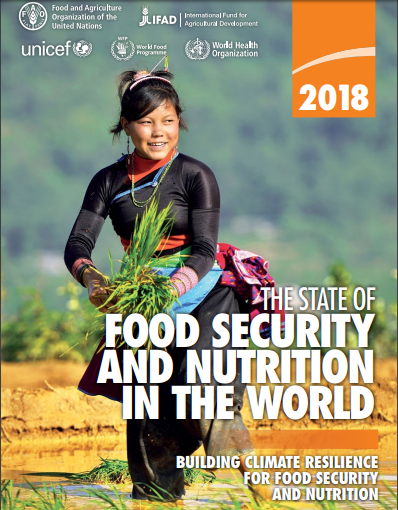Climate variability and extremes among key drivers of rise in global hunger, UN report says
- September 20, 2018
- Posted by: administrator
- Category: Environmental, Global

A new report on food security from the United Nations has found that climate variability affecting rainfall patterns and agricultural seasons, and climate extremes such as droughts and floods, are among the key drivers behind the rise in hunger, together with conflict and economic slowdowns.
The annual UN report The State of Food Security and Nutrition in the World 2018says that new evidence continues to signal that the number of hungry people in the world is growing, reaching 821 million in 2017 or one in every nine people.
Hunger has been on the rise over the past three years, returning to levels from a decade ago. This reversal in progress sends a clear warning that more must be done and urgently if the Sustainable Development Goal of Zero Hunger is to be achieved by 2030.
“The alarming signs of increasing food insecurity and high levels of different forms of malnutrition are a clear warning that there is considerable work to be done to make sure we ‘leave no one behind’ on the road towards achieving the SDG goals on food security and improved nutrition,” the heads of the UN Food and Agriculture Organization (FAO), the International Fund for Agricultural Development (IFAD), the UN Children’s Fund (UNICEF), the World Food Programme (WFP) and WHO warned in their joint foreword to the report.
“If we are to achieve a world without hunger and malnutrition in all its forms by 2030, it is imperative that we accelerate and scale up actions to strengthen the resilience and adaptive capacity of food systems and people’s livelihoods in response to climate variability and extremes,” the leaders said.
Impact of climate variability and extremes on hunger
Changes in climate are already undermining production of major crops such as wheat, rice and maize in tropical and temperate regions and, without building climate resilience, this is expected to worsen as temperatures increase and become more extreme.
Analysis in the report shows that the prevalence and number of undernourished people tend to be higher in countries highly exposed to climate extremes. Undernourishment is higher again when exposure to climate extremes is compounded by a high proportion of the population depending on agricultural systems that are highly sensitive to rainfall and temperature variability.
Temperature anomalies over agricultural cropping areas continued to be higher than the long-term mean throughout 2011–2016, leading to more frequent spells of extreme heat in the last five years. The nature of rainfall seasons is also changing, such as the late or early start of rainy seasons and the unequal distribution of rainfall within a season.
The harm to agricultural production contributes to shortfalls in food availability, with knock-on effects causing food price hikes and income losses that reduce people’s access to food.
The report is calling for greater efforts to build climate resilience through policies that promote climate change adaptation and mitigation, and disaster risk reduction.
Click here to download the full report
